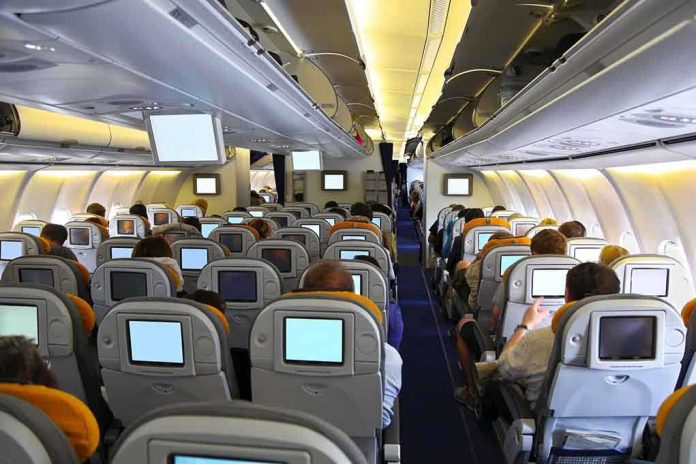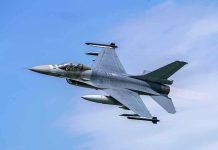
Passengers on a routine American Airlines flight were thrust into panic and confusion as sickening fumes swept through the cabin, triggering an emergency return to Los Angeles and reigniting debate about the invisible risks of commercial air travel.
Story Snapshot
- American Airlines Flight 274 returned to LAX minutes after takeoff when passengers and crew reported strong fumes and illness.
- Pilots donned oxygen masks and initiated an emergency landing; seven people were medically evaluated, none hospitalized.
- No hazardous substances were detected, but the aircraft was taken out of service for further inspection.
- This event follows a similar Delta Airlines incident earlier in the week, raising concerns about cabin air quality and airline safety protocols.
Rushed Takeoff, Rapid Unraveling: What Happened Onboard Flight 274
American Airlines Flight 274 pushed back from Los Angeles International Airport on October 14, 2025, destined for New York’s JFK. Within minutes of takeoff, the mood in the cabin shifted from routine anticipation to alarm. Passengers began to report a powerful, unfamiliar odor—and almost immediately, several started to feel sick. The situation escalated quickly: even the flight crew was affected, forcing the pilots to don oxygen masks and issue a mayday call to air traffic control. The jet looped back and landed safely at LAX, where emergency responders awaited the shaken passengers and crew. Seven people were medically evaluated onsite, but—remarkably—none required hospitalization. Yet, despite the sickening symptoms and swift emergency response, no hazardous substances were found during the post-incident inspection. The aircraft was taken out of service, and the passengers were shuffled onto a replacement flight bound, once again, for New York.
The incident was not an isolated anomaly. Earlier that same week, a Delta Airlines flight had returned to Heathrow after smoke filled its cockpit, further fueling anxieties about the air passengers and crew breathe while sealed in a pressurized tube at 35,000 feet. The swift, coordinated reaction from American Airlines’ crew and the Los Angeles Fire Department underscored both the seriousness and unpredictability of such “fume events”—a term that has haunted aviation for decades but rarely draws the spotlight unless multiple people fall ill and an airliner is forced to turn around.
Behind the Recirculated Air: Cabin Fumes and Their Shadowy History
Fume events are not new to the aviation world. For years, flight attendants and pilots have raised alarms about mysterious odors, sudden illness, and unexplained symptoms that strike both crew and passengers. The typical culprit: contaminated air seeping into the cabin through the aircraft’s ventilation systems, sometimes due to oil leaks, malfunctioning parts, or other system failures. Industry watchdogs and regulatory agencies have debated the frequency and severity of these incidents, with some experts arguing that the risks are underreported and not fully understood. The result is an uneasy truce: airlines tout robust safety records, while unions and advocacy groups call for better detection systems and more transparent reporting of air quality issues.
Flight 274’s emergency return was both a reminder and a warning. Despite technological advances and heightened safety protocols, the risk of sudden, unexplained air quality issues persists. The fact that no hazardous substances were found—despite clear symptoms—raises uncomfortable questions. Are detection systems missing something? Are certain contaminants simply undetectable with current inspection methods? Or is the heightened sensitivity a byproduct of post-pandemic anxiety, with travelers now hyperaware of every cough, odor, or twinge of discomfort?
Stakeholders and Power: Who Answers When the Air Turns Sour?
Responsibility in aviation emergencies falls along clearly defined lines. American Airlines, as the operator, is on the hook for both the immediate response and the longer-term public trust. The flight crew holds command during any crisis, making life-or-death decisions in seconds. Passengers, though powerless in the moment, wield outsized influence after the fact—through complaints, social media, and the court of public opinion. The Los Angeles Fire Department delivers the first medical response, while the Federal Aviation Administration may launch its own investigation into potential systemic risks. The incident places pressure on all parties: airlines to maintain safety and reputation, regulators to demonstrate oversight, and the flying public to demand transparency and accountability.
American Airlines issued a prompt public apology, emphasizing the unusual nature of the event and their commitment to safety. Yet, behind the corporate statements, a more pointed debate brews: how many close calls or unexplained illnesses are acceptable in an era of relentless air travel? What, if anything, will it take for airlines and regulators to invest in next-generation detection and filtration systems? The power dynamic increasingly favors those who can control the narrative—and passengers, armed with smartphones and social platforms, have never been more capable of turning a single incident into a national conversation.
Industry Impact and the Call for Answers
The immediate outcome of Flight 274’s ordeal was disruption: delayed journeys, anxious passengers, operational headaches, and a plane grounded for inspection. The longer-term consequences may prove more profound. Each high-profile fume event chips away at consumer confidence and prompts renewed calls for regulatory action. There are economic costs—lost time, emergency response, inspections, and potential compensation. There are social costs—public anxiety and the specter of invisible risks. And there are political costs, especially if lawmakers sense an opportunity to demand tougher standards for air quality monitoring and reporting.
Aviation safety experts continue to insist that such events are rare and that commercial flight remains statistically safer than nearly any other form of travel. Still, the recurrence of similar incidents across multiple airlines and aircraft types suggests that the issue is not isolated. Researchers and industry insiders press for more comprehensive data collection, standardized protocols, and ongoing health monitoring for those most exposed: flight crews and frequent flyers. Until then, every headline-grabbing return to the runway is a warning shot—a reminder that, sometimes, what you can’t see or smell is the very thing that deserves the most urgent scrutiny.
Sources:
Travel and Tour World (industry analysis)






